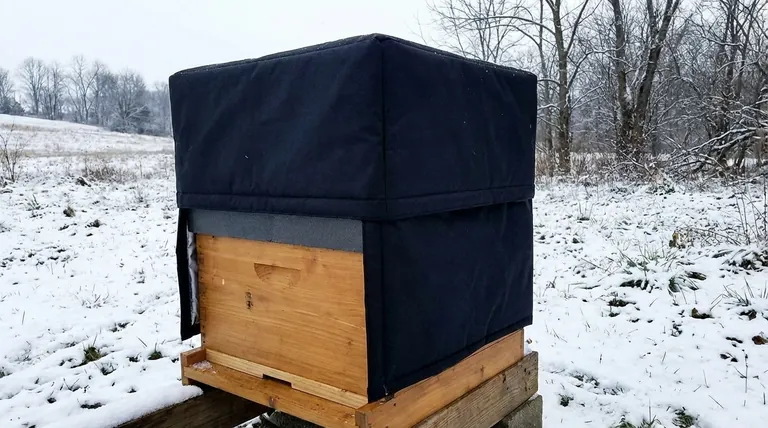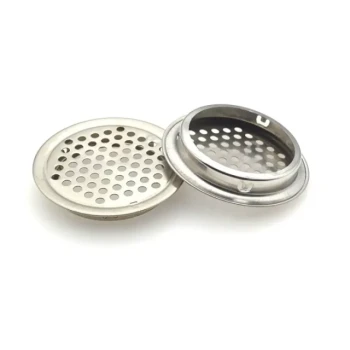In severely cold weather, proper insulation is a critical tool for ensuring a honey bee colony's survival. It functions by trapping the radiant heat generated by the bees' winter cluster, creating a stable microclimate that reduces energy expenditure. This allows the colony to conserve its vital honey stores and emerge stronger in the spring.
The primary role of hive insulation is not to heat the entire hive, but to help the bees manage their own energy more efficiently. By reducing heat loss and controlling moisture, you are directly investing in the colony's strength and long-term viability.

The Core Functions of Hive Insulation
Insulation works by addressing the two greatest threats to a colony in winter: heat loss and moisture. Understanding how it manages both is key to using it effectively.
Trapping Radiant Heat
A wintering bee colony forms a tight cluster and generates heat by vibrating their flight muscles. This process consumes a significant amount of energy, which comes directly from their stored honey.
Insulation, whether it's a hive wrap or foam board, acts as a thermal barrier. It dramatically slows the rate at which this precious, self-generated heat escapes the hive into the cold outside air.
This creates a more stable temperature zone around the cluster, much like a winter jacket creates a pocket of warm air around your body.
Reducing Energy Consumption
By trapping heat more effectively, the bees do not have to work as hard or consume as much honey to maintain the necessary temperature within their cluster.
This conservation of energy is the single most important benefit of insulation. A colony that burns through its honey stores too quickly risks starvation before spring flowers bloom.
Conserving these resources means the colony not only survives but has more energy reserves for raising new brood as spring approaches.
Managing Deadly Condensation
Bees constantly release warm, moist air through respiration. When this air rises and hits a cold inner cover, it condenses into water droplets.
This cold water can drip back down onto the cluster, chilling and killing the bees. Wet bees are dead bees.
Placing insulation directly on top of the inner cover (but under the telescoping outer cover) keeps that surface warmer. This raises the dew point, preventing condensation from forming above the cluster and keeping the bees dry.
Understanding the Trade-offs
Insulation is a powerful tool, but it can cause harm if implemented incorrectly. The most common mistake is failing to account for air exchange.
Insulation Must Be Paired with Ventilation
While insulation helps manage moisture by preventing condensation, it does not remove the moist air from the hive. A completely sealed, insulated hive is a recipe for disaster.
The hive must still have adequate ventilation to allow moist air to escape. This is often achieved with a small upper entrance or a slightly propped inner cover.
The goal is a dry, insulated hive, not an airtight one. You want to retain heat while allowing humid air to vent.
You Are Insulating the Cluster, Not the Box
A common misconception is that insulation is meant to keep the entire interior of the hive box "warm." This is incorrect and impractical.
The goal is to insulate the space around the bee cluster. The far corners of the hive will still be cold, and that is perfectly fine. You are simply making it easier for the bees to heat their immediate living quarters efficiently.
Material Choices Matter
Insulation comes in many forms, from commercial hive wraps to rigid foam boards. Wraps, especially dark-colored ones, offer the added benefit of absorbing solar radiation during the day.
Top insulation (like foam board) is arguably the most critical component because heat rises and that is where the most dangerous condensation occurs.
Making the Right Choice for Your Goal
Your approach to insulation should align with your specific objectives for the colony.
- If your primary focus is basic winter survival: Prioritize top insulation to prevent condensation and a simple wrap to serve as a windbreak.
- If your primary focus is a strong spring buildup: Implement both top and side insulation to minimize honey consumption, ensuring the colony has maximum energy reserves for early brood rearing.
Ultimately, viewing insulation as a strategic energy management tool empowers you to help your bees not just survive the winter, but thrive in the spring.
Summary Table:
| Function | Benefit for the Colony |
|---|---|
| Traps Radiant Heat | Creates a stable microclimate around the winter cluster. |
| Reduces Energy Consumption | Conserves vital honey stores, preventing starvation. |
| Manages Condensation | Prevents deadly water droplets from forming on the bees. |
Equip your apiary for winter success with HONESTBEE.
Proper insulation is a cornerstone of effective hive management. For commercial apiaries and distributors, ensuring colony survival and a strong spring buildup is critical for productivity and profitability.
HONESTBEE supplies durable, effective beekeeping supplies and equipment designed for harsh conditions. Our wholesale-focused operations provide the reliable gear you need to protect your investment.
Contact our team today to discuss your winter equipment needs and secure your colonies' future.
Visual Guide

Related Products
- Professional Insulated Winter Hive Wrap for Beekeeping
- Inner Beehive Cover for Beekeeping Bee Hive Inner Cover
- Professional Insulated Plastic Bee Hives
- Telescopic Beehive Outer Cover Lid Roof with Galvanised Sheeting for Langstroth Hive and Beehive Outer Cover
- Wholesales Dadant Size Wooden Bee Hives for Beekeeping
People Also Ask
- Is it always necessary to insulate beehives? A Guide to Winter Survival & Colony Health
- What is the advantage of an insulated outer cover? Boost Winter Survival & Spring Buildup
- What are the steps to properly wrap a beehive for winter? Ensure Your Colony Survives the Cold
- What are the benefits of insulated beehives in cold weather? Boost Winter Survival & Spring Productivity
- What are the durability features of Bee Blankets? Built to Last in Demanding Apiary Conditions



















